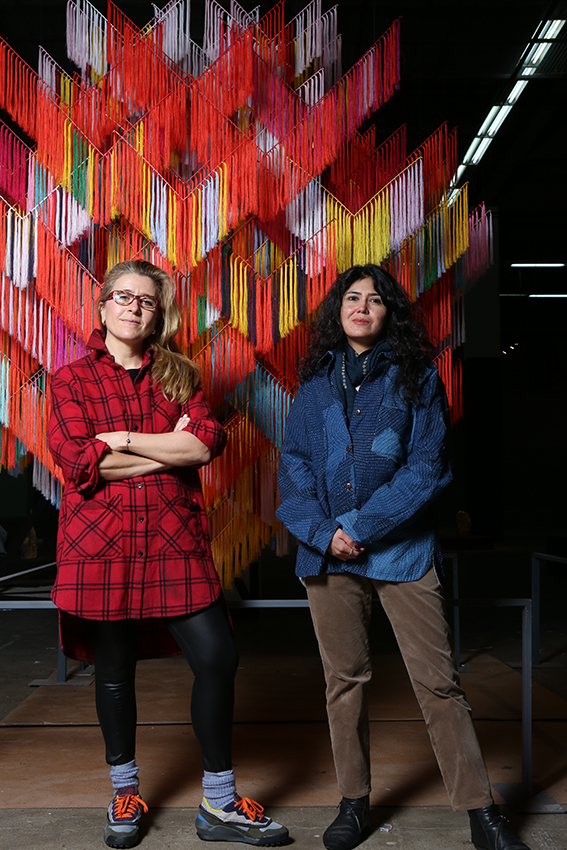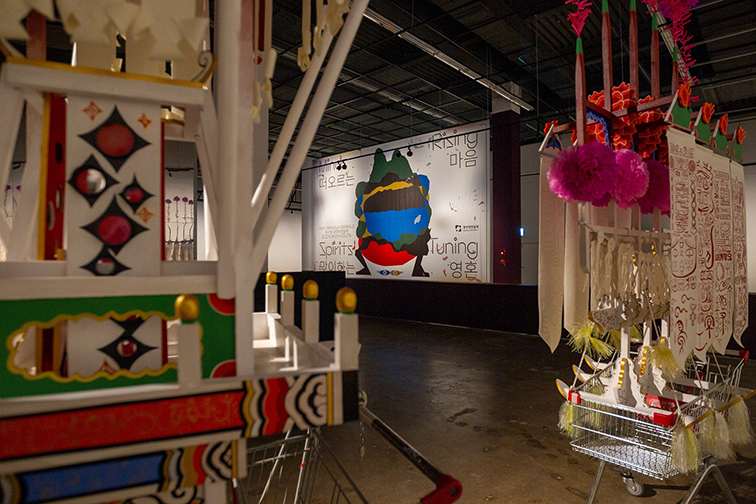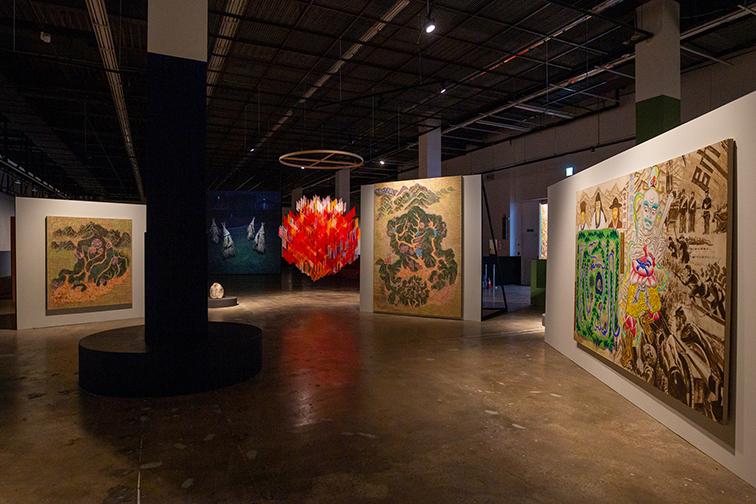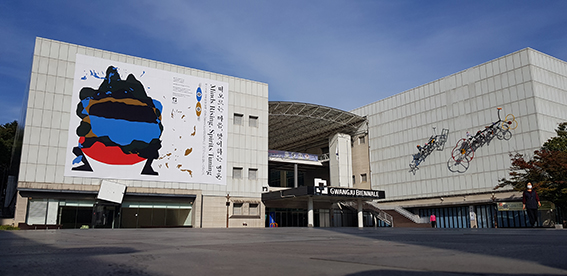Minds Rising, Spirits Tuning
Interview with the Biennale Artistic Directors.
Interview by William Urbanski.
Founded in 1995 in memory of the civil uprising of the 1980 Gwangju Democratization Movement, the Gwangju Biennale has reached its 13th running this year, which is from April 1 to May 9. The artistic directors of this edition are Defne Ayas and Natasha Ginwala, whom we at the Gwangju News have had the pleasure of interviewing. — Ed.
Gwangju News: (GN): Thank you for taking the time to do this interview. First of all, could you please introduce yourselves to our readers?
— Natasha Ginwala: I am a curator, writer, and editor based in Sri Lanka and Berlin. My interests lie in seeking collective methods of cultural production and collaboration, especially across Asia; feminist practices in the arts, and in the social sphere; as well as in ways in which the contemporary arts relate with civic challenges that we face globally. I am directing an interdisciplinary arts festival, Colomboscope, in Sri Lanka and am engaged as associate curator at Gropius Bau in Berlin.
— Defne Ayas: I am a curator, currently serving as co-artistic director of the 13th Gwangju Biennale, and a curator at large at the V-A-C Foundation in Moscow/Venice. I have previously worked as a director and curator of several cultural institutions and research initiatives around the world, including in Rotterdam, Shanghai, New York, and Moscow.

GN: The theme for this year’s Gwangju Biennale is “Minds Rising, Spirits Tuning” and deals with, from what I understand, exploring organic and communal intelligence. How are art and exhibitions going to be used to explore these ideas?
— Natasha Ginwala: The 13th Gwangju Biennale explores some of the most pressing questions of our present era, namely, how we understand the complex relationship between organic and machinic intelligence, between human and non-human forms of life; the passage between death, mourning, and the afterlife; as well as the social models and intelligences that are hidden and remain oppressed through actively engaging with indigenous, ancestral, queer, and matriarchal modes of being in the world today. The exhibition is spread across three external venues: the Gwangju National Museum, Horanggasy Artpolygon in Yangnim-dong, and the Gwangju Theater, in addition to the five galleries of the Gwangju Biennale Hall. Each have their own narrative, and therefore, audiences will be guided through the various aspects of the artistic and scientific inquiry, bringing together local and international artists and thinkers.
— Defne Ayas: Minds Rising, Spirits Tuning sets out to examine the spectrum of the extended mind – to challenge the structural divisions imposed on corporeal, technological, and spiritual intelligences – and seeks to bring forth dynamic aspects of the communal mind and its artistic and restorative potential in current struggles toward social justice. These themes are dealt with in the exhibition in a variety of ways and through a multitude of artworks in the Biennale. Sixty-nine artists – including thinkers, activists, and journalists – are participating, and we have consciously chosen to work with artists whose work embodies these qualities and ideas. For example, works on display actively draw from the visual culture of Korea, beyond the field of contemporary art, and focus on oral cultures, rural cosmologies, and forms of labor in agrarian life, laying the groundwork for intelligences of the “communal mind” to continually emerge. An example to highlight here is the participation of PARI (People’s Archive of Rural India), an organization that accrues oral cultures and poesies of rural women who convene around the grind mill, unveiling lessons on seasonal changes, women’s labor, caste politics, familial relationships, and festivities.

Other artistic propositions tap into machine learning while addressing what lies in excess of algorithmic perception, how to use and sculpt data differently, and the restructuring of the relationalities between physical and virtual, online and offline, private and public. For example, John Gerrard’s intensive engagement with neural networks and deep learning and Ana María Millán’s virtual world-building exercise, both animate protagonists as a means of spatializing narrative logic and chronicling ecological precarity, gender disparity, and state-led militarist violence. Another example is the diagrammatic lexicons by Kate Crawford, Vladen Joler, and Matteo Pasquinelli, which we are presenting to reveal the complex networks of human labor, data extraction, wealth distribution, and planetary exhaustion.
GN: What are the major takeaways you would like visitors to the 2021 Gwangju Biennale to leave with?
— Natasha Ginwala: Minds Rising, Spirits Tuning creates a planetary viewfinder and pathways through many of the upheavals and transformations of the time we are living through. We hope that audiences will find their own connections and stories through these artistic offerings. The ground floor of the Biennale Hall is accessible free to the public for the very first time with distinctive exhibition architecture by Diogo Passarinho. The sensorial forms and openness of the exhibition are ways to plot intimate and social encounters with the Biennale that is quite unique, especially given that over the last year, our bodies and minds have faced a severe alienation and separation from the vibrant intelligence that comes from ecology, living traditions, and sociality.
GN: You are working as co-artistic directors for the Gwangju Biennale. What are some challenges of working on a team for such a major project? Do you ever step on each other’s toes, so to speak?
— Natasha Ginwala: The world has transformed since we took up this Biennale directorship. There have been many hardships in working through the pandemic that affect the lives and creative capacities of our international and local team as well as each of the artists. We were unable to travel to Gwangju for an entire year after making in-depth research visits with artists and team members. However, artists have produced phenomenal installations in a range of mediums, and we are excited to reveal these for the city’s audiences. The construction and installation phase of this Biennale edition also held unique challenges, since the few who traveled endured strict quarantine measures and needed to always remain alert while working onsite. We are grateful that the process continued with a positive energy and commitment from the exhibition coordinators and hired companies. There have been two postponements and the Biennale’s duration has been shortened. This has made it impossible for numerous people to be present for the official opening ceremony of the Biennale, and that is hugely disappointing for us, our artists, and team. We hope the spring will bring a sense of renewal and ease in Korea.
— Defne Ayas: We have been friends and colleagues for a long time. We were approached in January 2019 to put together a joint proposal for the Biennale, and that March we made our first trip to Korea together. By then we already shared certain intuitions about venues and interests, which anchored much of our early process. That was two years ago, and we have since continued to work together to realize those shared ideas.

GN: You both have a wealth of international experience. In what ways do you think this experience will help deliver the message of this year’s Biennale?
— Natasha Ginwala: Our international partnerships have been crucial in gaining support towards the realization of 40 artist commissions, some of which will be featured in international exhibitions at partner institutions such as Kunsthall Trondheim in Norway and Bonniers Konsthall in Sweden. Our curatorial and programs teams are based in Korea and six other countries, and they have carried out this monumental collaborative effort throughout the pandemic, including presenting specialized digital content that is artistic, literary, and scientific. We have been committed to extending a dialogue about feminism, gender justice, and sexual violence as part of this Biennale edition. To this end, we have worked with a gender-diverse, intergenerational group of artists and thinkers, as well as produced the reader Stronger Than Bone, co-published by Berlin-based Archive Books and the Gwangju Biennale Foundation. Various museums and private collectors have trusted our vision and been generous in loaning artists’ works to the 13th Gwangju Biennale from India, Haiti, New Zealand, Qatar, and beyond. We hope local audiences will enjoy these compelling artistic expressions.
GN: Lastly, on a more general note, what are your impressions of Gwangju and, in particular, the city’s ongoing enthusiasm and support for the Biennale?
— Natasha Ginwala: We greatly enjoyed our visits to Gwangju and engaging with the cultural communities including artists, human rights activists, theater makers, historians, and students. Despite the ongoing pandemic, we were able to expand connections between international artists and various organizations, but also local residents became collaborators with Biennale artists given the nature of their projects, including a quilt maker, baker, gong maker, dancers, esteemed Seon Buddhist nun, and expert in temple food Jeong Kwan, who played an important role in the opening procession “Through the Gates.” Also participating in the opening procession were children practicing taekkyeon and samul-nori performers who participated with artists such as Angelo Plessas, Eight OS, Cecilia Bengolea, Siyabonga Mthembu, and Kim Sangdon as collaborators for the procession recording led by our producer Davide Quadrio.
— Defne Ayas: The cultural ecology of Korea has a demand for art, which is a great thing for the Biennale, particularly this year, when the audiences – of the exhibition element, at least – will be local, rather than international. The Gwangju Biennale is Asia’s largest, oldest, and most prestigious biennial of contemporary art with an international reputation, but of course, it is firmly anchored in its local context. Our impression is that it continues to draw its energy from the legacy of the Gwangju Uprising, and every two years it sparks discussion about this traumatic experience, as well as passionate interest and discussion from the local community.

GN: We appreciate the work that you have done in creating this year’s Gwangju Biennale. I personally can’t wait for the chance to go and see the fruits of your labor. Thank you for giving of your time for this interview.
Photography courtesy of the Gwangju Biennale Foundation.







